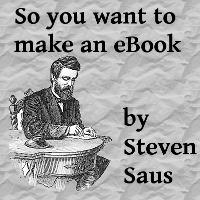 This post is part of So You Want to Make an eBook?. I’m releasing this book in sections on my blog, but when it’s all finished I will offer the whole thing as a single eBook. Everyone who donates toward its production (use the coffee cups to the right, note that it’s because of this effort) will get a free copy of this eBook. You can find all the posts here.
This post is part of So You Want to Make an eBook?. I’m releasing this book in sections on my blog, but when it’s all finished I will offer the whole thing as a single eBook. Everyone who donates toward its production (use the coffee cups to the right, note that it’s because of this effort) will get a free copy of this eBook. You can find all the posts here.
The Philosophy of eBooks
There is something key to understanding eBooks: Content is king.
Much to the chagrin of font geeks and layout artists everywhere, real eBooks reflow. That means the line breaks change when you zoom the page. On the other hand, when you zoom a PDF file, part of the page goes off the screen.
(This is something that’s easier to show with websites. If you go to my website (opens in a new window or tab) and shrink your window, the text will (to an extent) reflow. Words wrap around so you can still read all of them. This blog template, however, doesn’t, so shrinking the window means that you’re missing stuff pretty quickly.)
An eBook has a limited number of fonts to choose from – especially if you want it to display correctly in all readers. Fancy fonts won’t save you: this means that your words are what makes the book valuable.
That said, the layout can get in the way of your content. Here are a few examples illustrating these problems:
The text can be squished together. Lines can break halfway through a sentence. Quotation marks can be different sizes from your text. Large file sizes make pages load more slowly. Footnotes and endnotes do not include return links to the main text. Images are scaled too large or too small. These are all small irritations – but they add up. These problems make your words look unprofessional.
This is a common problem with converting software. I have yet to discover any software that creates valid, professional looking eBooks every time. While software has come a long way – Sigil in particular – it’s not there yet. Earlier this week I proofed some work done with Sigil that still had a good half-dozen (admittedly minor) problems. While it’s tempting to think this is just a problem with free software, even InDesign, a professional retail package, sometimes embeds fonts in a non-standard way.
This book concentrates on creating high-quality eBooks for you to sell (or give away) on your own site. You can also upload the resulting documents to Barnes & Noble, Amazon, and any other store that will accept an ePub or Mobi/Kindle formatted document. I will walk you through the process for Amazon and Barnes & Noble, but again, I encourage you to sell your own creations. You will retain more control and make more per sale.
I do not cover Smashwords. My first two jobs creating valid eBooks consisted of fixing Smashword-converted documents. While I am told that their program has gotten better, that does not suffice for me. Smashwords (as of the last time I checked) still requires you to use their converting software even if you have a completely valid ePub file. Because our focus here is on making quality work, I am skipping Smashwords entirely.
Likewise, I do not cover Scribd. In the summer of 2010, they changed their policy about the availability of work on the site. In short, if your work did not sell enough, they would put it behind a paywall. This seems to be missing the point; so why participate in that kind of deal?
Next week, we’ll talk about the things you need to know and the software (ensuring it’s free or free variants exist) that you’ll need before we begin. Thanks to everyone who has commented and supported so far!
This post was part of So You Want to Make an eBook?. I’m releasing this book in sections on my blog, but when it’s all finished I will offer the whole thing as a single eBook. Everyone who donates toward its production (use the coffee cups to the right, note that it’s because of this effort) will get a free copy of this eBook. You can find all the posts here.



Just FYI, Sigil left in much more than a half-dozen problems. What you saw were the ones that I missed when I went through my own clean-up of the file.
Not huge problems, but I spent a fair amount of time code-cleaning that second file I sent you.
Maybe it's not improved that much, then. What I've found is that most problems don't manifest on all machines or platforms… only some of them. Entity references are a good example – some might take the name, other only take the number.
Some stores also make a big deal about specifics like that; it must be "well formed" even beyond simple "valid" ePub.
Thanks for letting me know that, man!